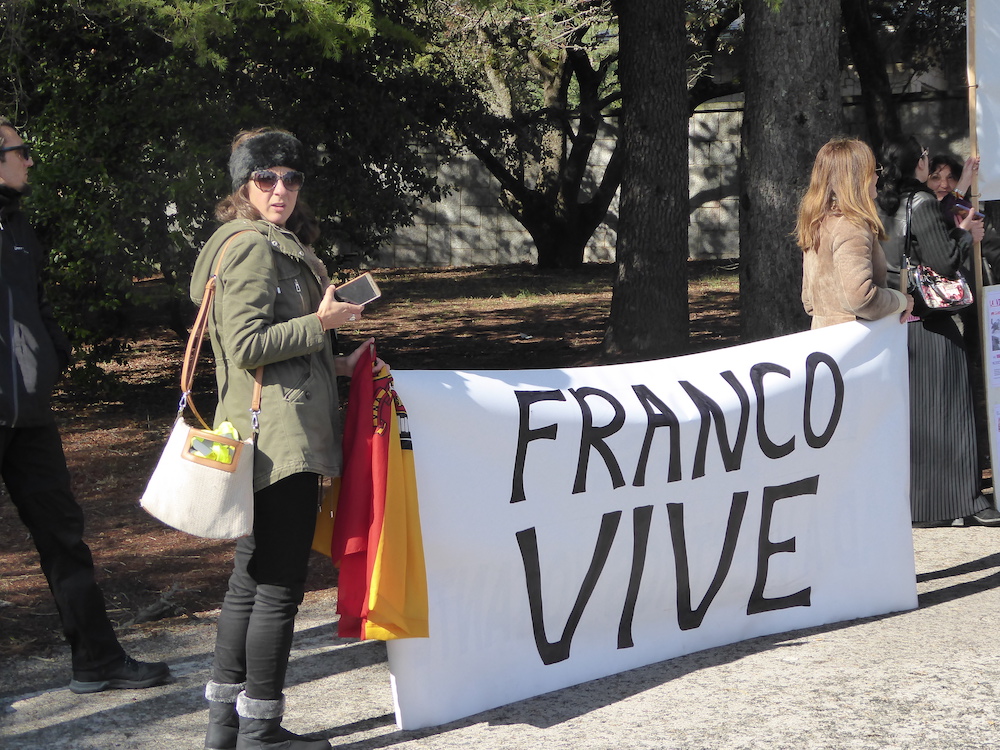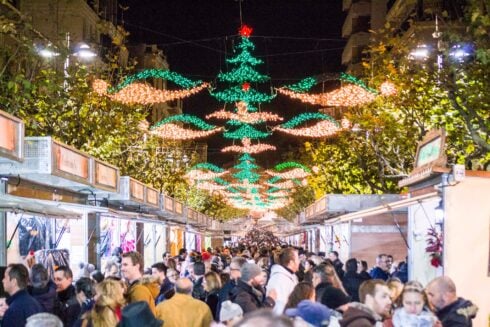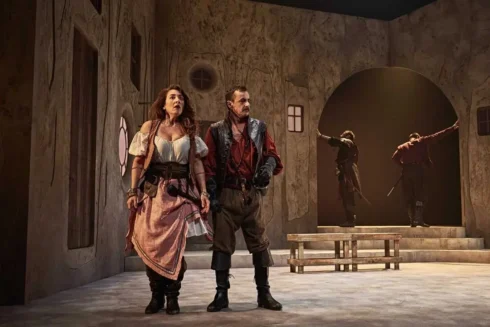
IN the event, it was an ignominious affair with even Franco’s staunchest supporters in short supply.
What had been billed as a momentous occasion – something of a seminal turning point in Spain’s traumatic history – turned out to be a distinct anti-climax.
With more of a whimper than a bang, the former dictator’s remains were finally unearthed from their burial place under the basilica at the Valley of the Fallen and taken somewhat unceremoniously by helicopter to their new location, also near Madrid.
Without any of the pomp and circumstance of his first send-off almost 44 years ago, Francisco Franco was reinterred at Mingorrubio-el Pardo cemetery next to his wife, Carmen Polo.
The low-key transfer took place in front of just a handful of supporters and family and with only two members of the Franco clan allowed to see his actual digging up.
The family had fought tooth and nail with Pedro Sanchez’s socialist government for years to keep their grandfather’s embalmed body in the basilica next to his far-right Falangist hero, Jose Antonio Prima de Rivera.

But therein lay the problem – their bodies were in the vicinity of some 30,000 victims of the Spanish Civil War (many actually killed by Franco’s troops), for whom the monument was actually built.
The press and a handful of Franco diehards gathered at the entrance to the monument, built 40 kilometres north of Madrid, as the two family members watched the exhumation being carried out several kilometres away beneath the towering 150-metre high cross.
After being searched for recording devices, they stood within the screened-off area around Franco’s tomb along with Spain’s Minister of Justice Dolores Delgado, a forensic scientist and several other officials to record the historic event.
As we watched, alongside me there were murmurings of indignation and rage.
“The fact they have closed the basilica for two weeks and not allowed the faithful in to pray is an attack on Christianity and religious freedom,” Estefania Aguirre, 34, told me, adding that she was a personal friend of the Valley’s Benedictine Prior, Santiago Cantera, who fought along with the family against exhuming Franco’s remains.
“I think the whole exhumation has breached Church and State relations and we’re going to see more and more attacks against religious liberty in Spain.”
Her Barcelona-born mother Laura Wachter, brandishing a banner printed with the words ‘Estado Dictatorial’, likened it to the actions of a dictatorship.
“This is North Korea,” she said repeatedly. “It’s very sad that Spaniards are being pitted against one another when there are many more important issues to tend to.”
In another huddle the most vocal member, Pilar Gutierrez, who also happens to be a psychologist, was entertaining the press with her views.

“Some 8,000 people were killed just for being Catholic during the war and this is what this Government wants to bring back,” she railed.
“You can only expect the worst from the Socialists.”
Taking an equally strong line was a former member of Spain’s army, who came sporting his green beret.
“We are here to show our loyalty to our leader,” Lorenzo Fernandez Navarro, 69, told me. “When Franco died, I was a lieutenant in the Sahara. We swore to respect and obey our leaders. And always means always, whether they are alive or dead. We have come here to comply with our oath that this Government has insulted.”
Less vociferous was his colleague Adolfo Coloma, 66, who explained: “More than being about one side or the other, the monument stood for reconciliation.
“Franco will be desiccated like an Egyptian mummy; dry and hardened but with all his organs”
“We have managed to overcome the divisions in Spain. To speak now about who killed more people is bad news.”
Judging by how long it took before Franco’s body was raised heavenward by military helicopter, excavating the Caudillo was no easy feat.
Heavy machinery, including a forklift truck, rollers and a crane, had been on standby since October 11 and trundled into action at 10.30 am on the morning of October 24 to lift the 1,500 kilos of granite that covered the tomb.
Once the flagstone was removed, there was reportedly a layer of lead and cement to get through before the coffin could be lifted out.
Inside, Franco’s body was sealed in zinc which would have preserved it perfectly, according to Dr Antonio Piga, one of the forensics who embalmed the dictator on his death.

“The tomb will be dry and the body in perfect condition,” he insisted. “Franco will be desiccated like an Egyptian mummy; dry and hardened but with all his organs.”
Curiously though, there was no Spanish flag draped on the coffin as it was borne away on the shoulders of the family who had, by then, been waiting over two hours to receive it.
No doubt it was a bitter moment; a year ago, they called the exhumation ‘an act of retrospective revenge without precedent in the civilised world’.
Now, Europe’s last monument to a fascist dictator had finally morphed into something else.
After a 15-minute flight to Mingorrubio, just 50 kilometres away, the helicopter landed within the Royal Guard’s old firing range where 22 family members were waiting to follow the Caudillo’s body in a cortege towards the cemetery.
Security was tight. The gathering had been planned by the Franco Foundation ‘to pray for the soul of Francisco Franco Bahamonde’ and lay flowers on his tomb; but this was banned by the government the day before on the grounds it posed a risk to public order.
Reduced in size to include mainly family, the subsequent funeral was conducted in the cemetery’s Pantheon by Prior Santiago Cantera and, intriguingly, Ramón Tejero, the son of Lieutenant Colonel Antonio Tejero who infamously led 200 members of the Civil Guard in an attempted coup on February 23, 1981.
Spain’s national newspaper El País described the exhumation as Pedro Sanchez’s ‘most symbolic achievement’.
Click here to read more Spain News from The Olive Press.








